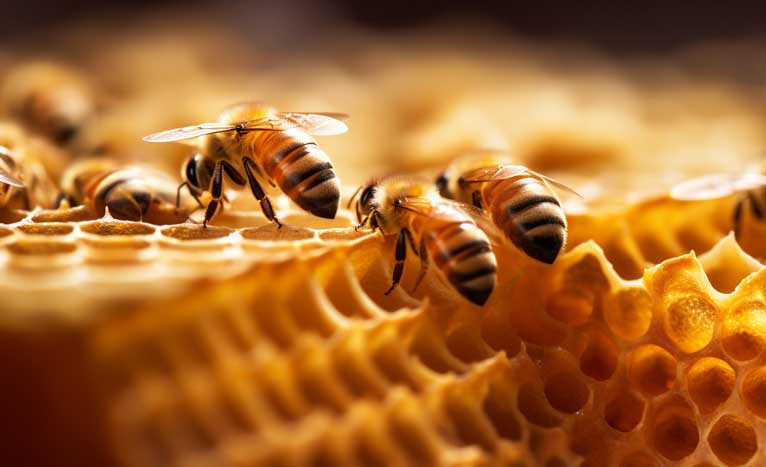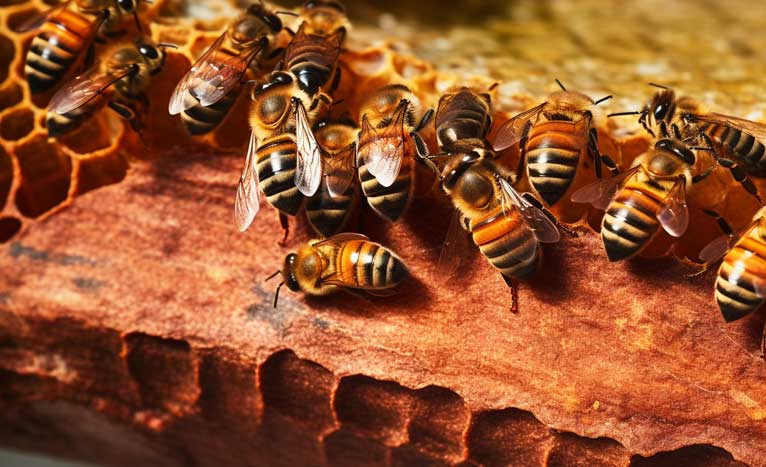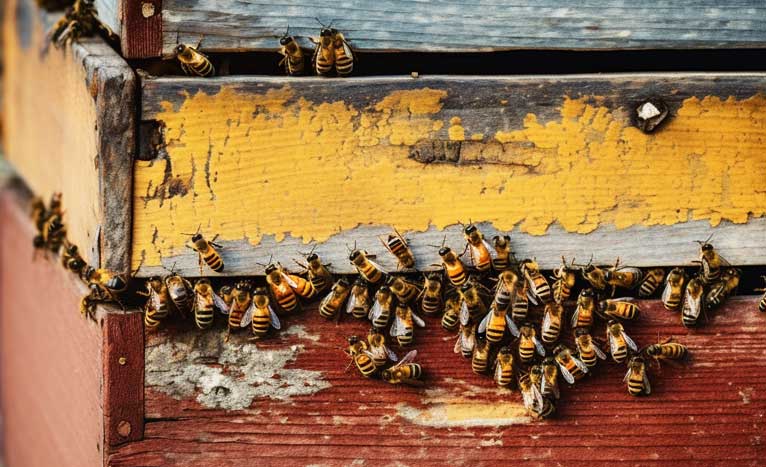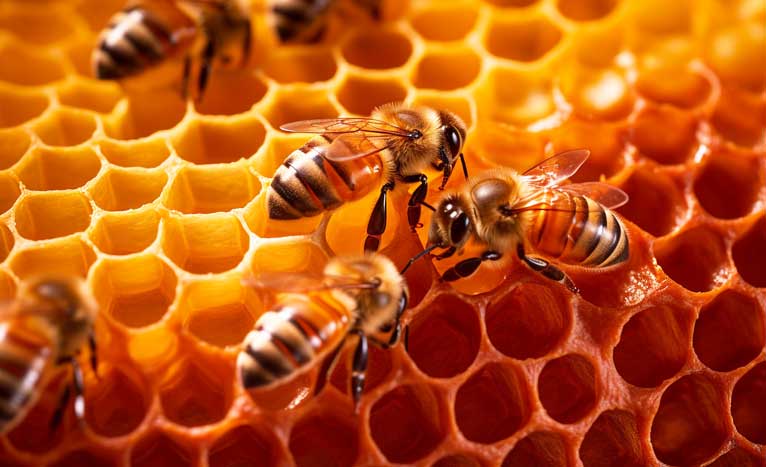As a beekeeper, one of the most important decisions you'll make is choosing the right type of beehive for your colony. Two popular options are wax and stained beehives. In this blog, we'll explore the differences between these two types of beehives and help you determine which is the better option for your bees.
On my homestead, I have had experience with both of these hives. I started with stained hives and now I am working with wax hives. After using both for my beehives, I have a preference and maybe you can guess which one I prefer while reading through the blog!

Wax Beehives
Wax beehives are made from natural beeswax, which is produced by bees themselves. These beehives are known for their high insulation properties, which help keep the bees warm during colder weather. Wax beehives are also relatively easy to work with, as they can be manipulated and shaped by heating the wax. Winterizing beehives and setting them up for success is hard as is. Wax beehives can make this process simpler with the natural encasement. For me, this is a positive due to my harsh winters.
One of the main advantages of wax beehives is that they are a natural material, which can be important for bee health. Bees have evolved to live in natural environments, and using natural materials in your beehives can help maintain a healthy colony. Wax beehives also have a pleasant, natural smell that bees are attracted to.
However, there are some drawbacks to using wax beehives. They can be more expensive than other types of beehives, as beeswax is a valuable material. Wax beehives can also be more difficult to maintain and clean than other types of beehives. Wax can melt at high temperatures, making it more susceptible to damage and warping. If you live in a place with extremely high temperatures and direct sun, wax hives could become an issue. I would suggest discussing this with the hive manufacturer.

Stained Beehives
Stained beehives are made from wood that has been treated with a wood stain. These beehives are known for their durability and longevity, as the stain helps protect the wood from weather and pests. Stained beehives also come in a range of colors, which can add a decorative element to your beekeeping setup. I stained my beehives with a dark brown, and you can stain them with whatever color you want!
After a year, the stain has held up well.
One of the main advantages of stained beehives is their durability. The stain helps protect the wood from weather and pests, which can help prolong the life of your beehives. Stained beehives are also relatively easy to maintain and clean, as the stain helps repel dirt and debris.
However, there are some drawbacks to using stained beehives. The stain may contain chemicals that can be harmful to bees, so it's important to choose a non-toxic stain. Stained beehives may also not have the same insulation properties as wax beehives, which can be a concern in colder weather. Eventually, the stain can wear off or wear unevenly and you will have to recoat it. This becomes an issue because you don’t want to stain the hives with the bees in it. The fumes could affect them and they could land in the wet stain. Overall, they can be a mess to deal with.
Which is the Better Option?
Ultimately, the choice between wax and stained beehives comes down to personal preference and the needs of your colony. If you prioritize natural materials and insulation, wax beehives may be the better option for you. If you prioritize durability and longevity, stained beehives may be the better option. Personally, I think wax beehives also have a longevity factor to them as long as they are cared for and you don’t live in a scorching hot area.
It's also worth considering the climate in your area. If you live in a colder climate, wax beehives may be better suited for your colony's needs. If you live in a warmer climate, stained beehives may be a better option.
No matter which type of beehive you choose, it's important to maintain and clean your beehives regularly to keep your colony healthy and thriving. With proper care and attention, your bees will be happy and productive in their new home.

Tips for Maintaining Your Beehives
Whether you choose wax or stained beehives, it's important to maintain them properly to ensure the health and productivity of your colony. Here are some tips for maintaining your beehives:
Regular Inspections
Regular inspections are crucial for identifying potential problems in your colony. During inspections, you should check for signs of disease, pests, or damage to the hive. Some key things to look for during inspections include:
Healthy brood: Check for healthy brood patterns and make sure that there are no signs of disease or infection.
Adequate food stores: Check that the bees have enough honey stores to sustain them through the active season and winter months.
Queen activity: Check that the queen is laying eggs and that there are no signs of queenlessness or drone-laying workers.
It's important to inspect your beehives at least once a month during the active season to ensure the health and productivity of your colony.
Cleaning Your Bee Hives
Cleaning your beehives is important for preventing the buildup of debris, wax, and propolis. Debris can attract pests and create a breeding ground for bacteria, which can lead to disease in your colony. You should clean your beehives at least once a year by scraping and brushing away debris and washing the interior with a mild soap and water solution.
It's important to avoid using harsh chemicals or cleaners that can be harmful to your bees. Instead, opt for natural cleaners like vinegar or lemon juice.
One neat thing I was able to do was to transplant a package of bees into my old beehive that didn’t survive the winter. The beehive that didn’t survive left behind honey, but also was filled with dead bees and some mold. Upon hive inspection, I noticed that the package of bees cleaned out the hive and is utilizing the stores. I was able to use what my old bees built to setup my new bees for success!
Feeding Your Bees
Feeding your bees is important during times of low nectar flow. This can occur during periods of drought or when there are limited sources of nectar available. You can feed your bees with sugar syrup or pollen patties. Make sure to use clean feeders and avoid feeding during times of cold weather.
It's important to monitor your colony's food stores to ensure they have enough honey to sustain them through the winter months. If you notice that your colony is running low on food, you can provide supplemental feeding to ensure their survival. I provided them with fondant through the winter and when I did my first hive check in the spring, I noticed that they had used the fondant! This may have saved my colony.
Bee Pest Management
Pests like varroa mites and wax moths can be a serious threat to your colony. It's important to use non-toxic pest management methods to keep your bees safe. Some effective pest management methods include:
Screened bottom boards: These can help control varroa mites by allowing them to fall through the screen and out of the hive.
Sticky traps: These can be used to trap wax moths and other pests.
Essential oils: Some essential oils, like tea tree oil or lemongrass oil, have natural pest-repellent properties and can be used to deter pests.
It's important to monitor your colony for signs of pests and take action immediately if you notice an infestation.
Bee Hive Winter Preparation
Preparing your colony for winter is crucial for their survival. Make sure your colony has enough honey stores to last through the winter and provide insulation with blankets or foam insulation. You should also consider reducing the size of your colony by combining weaker hives or removing excess frames to reduce heat loss
It's important to monitor your colony's food stores throughout the winter months and provide supplemental feeding if necessary. You should also monitor your colony for signs of disease or pests and take action immediately if you notice any problems. This will depend on your climate because you do not want to open the hive in cold temperatures as this can cause moisture issues in your hive and kill your hive. I would suggest connecting with a local beekeeping community and see how they manage their hives in the winter.

Choosing between wax and stained beehives is a personal decision that depends on your priorities and the needs of your colony. Both types of beehives have their advantages and disadvantages, and the decision ultimately comes down to what works best for you and your bees.
I prefer my wax hives because they are high quality and I love the natural aspect of my bees’ home environment not being a chemical stain.
No matter which type of beehive you choose, proper maintenance and care are crucial for the health and productivity of your colony. By regularly inspecting, cleaning, and feeding your bees, and managing pests, you can help your bees thrive in their new home.

